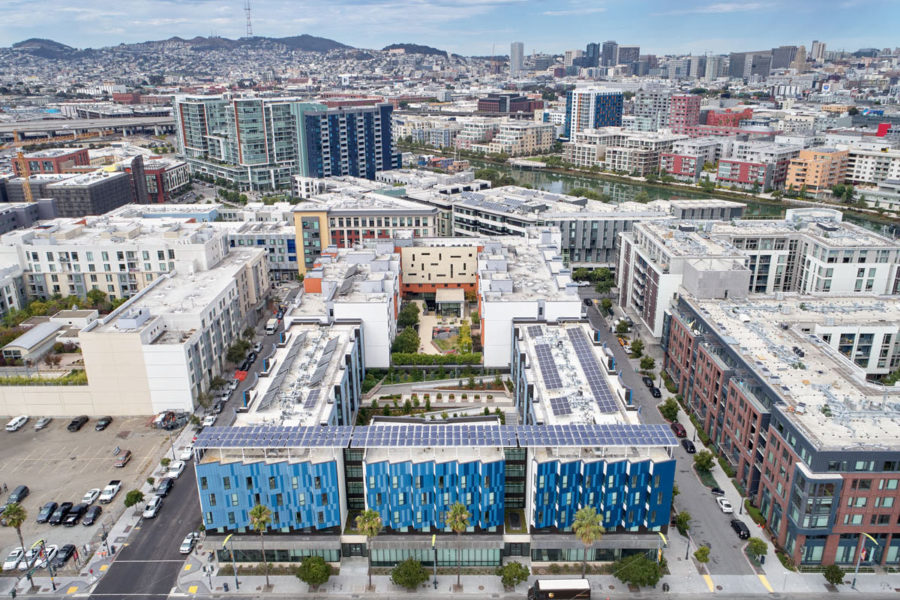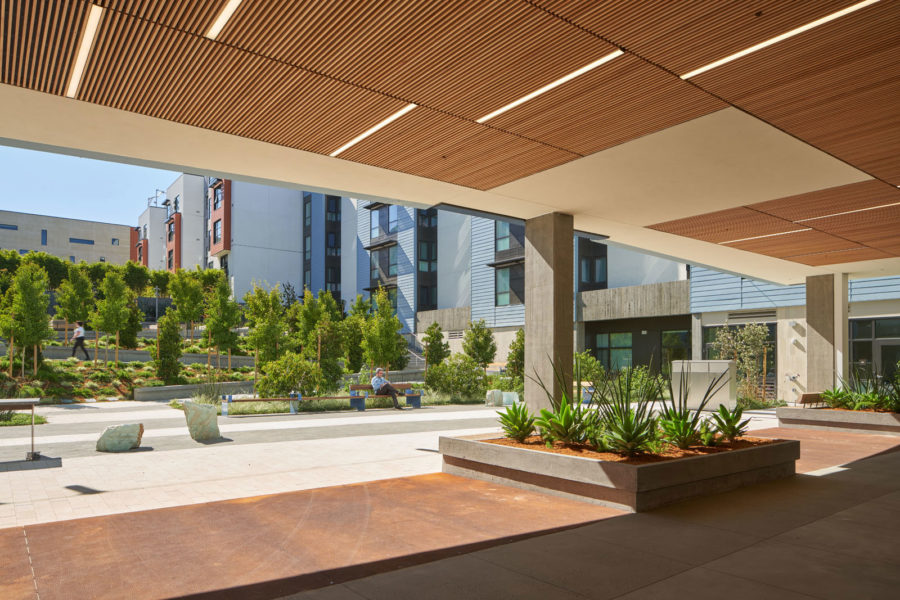Story at a glance:
- The Edwin M. Lee Apartments provide sustainable, low-carbon, supportive housing for families and homeless veterans in San Francisco.
- The building provides 62 apartments for formerly homeless veterans and 47 apartments for families earning between 50% and 60% AMI.
- The design features new green areas and flexible spaces centered around community.
Edwin M. Lee Apartments, San Francisco’s first combined homeless veteran and low-income family development, has set a new standard for integrated, equitable, and resilient living.
Edwin M. Lee, the late San Francisco mayor from 2011 to 2017, was the son of a veteran. He made housing and veterans issues a core of his agenda, and he signed the Mayors Challenge to End Veteran Homelessness during his time in office; it was a program instituted by First Lady Michelle Obama in 2014. The Edwin M. Lee Apartments is a manifestation of the mayor’s dedication to provide sustainable, low-carbon, supportive housing for families and homeless veterans in San Francisco.
In San Francisco’s Mission Bay neighborhood, the project site faces Third Street, a primary transportation artery within the relatively new post-industrial neighborhood. The project is operated by nonprofits Swords to Plowshares and Chinatown Community Development Center, and it provides 62 apartments for formerly homeless veterans and 47 apartments for families earning between 50% and 60% AMI. The building also provides ground-floor services for residents, neighbors, and the greater community. Amenities include a large community room and kitchen (available to the public as well as residents), a computer lab, separate community rooms for teens and kids, onsite resident services, laundry facilities, a large central courtyard, and a community garden.

Edwin M. Lee Apartments. Photo by Bruce Damonte
The design of the building focuses on integrating veterans, families, and connections to nature and the broader community. During design, the team considered different aspects of this goal—balancing the desire to encourage connection among these resident groups with different needs who may not otherwise intersect, with designing for the specific needs of veterans versus young families.
The team considered trauma-based design and universal design principles, as they worked to create a welcoming home for veterans and provide dedicated programmed spaces for kids and teens, incorporating both needs in the shared courtyard space. These specific strategies and solutions arrived with collaboration from the experienced nonprofit developers, research on designing for veterans with disabilities experiencing chronic homelessness, responsive design to the site-specific resilience challenges of Mission Bay, and feedback from community members and stakeholders.
At the site scale, the square-shaped lot was optimized to allow for a generous interior courtyard footprint, which allowed for multi-layered passive and active programming opportunities, diversity of vegetation, and scales of gathering spaces to take place. The courtyard introduced 36 new evergreen and deciduous trees to the previously barren landscape, creating a forest-like setting with ample access to sunlight year-round.

Photo by Bruce Damonte
At the lower level of the courtyard is an open, flexible space with a barbecue and direct connection to the indoor community room and community kitchen; the upper level of the courtyard is dedicated to the community garden, for residents to grow vegetables and herbs. The courtyard also contains informal steps composed of reclaimed lumber and found granite slabs recovered from the site during demolition; a ball wall for kids; a pet relief area; several semi-private seating options for respite and meditation; connections to the ground floor laundry rooms; deep planters to treat stormwater; and extra-wide sloped paths for users of all abilities—strollers, wheelchairs, leashed pets, and walkers can be seen ambulating on the paths throughout the day. The space was crucial for the veterans’ counseling services to use during the Covid pandemic; many of the group therapy programs used the courtyard as a safe gathering area during the public health crisis.
The large lot also allowed the building facade to be modulated to capitalize on natural daylight and long views of the bay and the Third Street corridor. The Third Street facade, more than 200 feet long, was segmented into three sub-volumes, providing relief and natural daylight to the corridors and green roofs at the second-floor level. The facade’s serrated skin unfolds to a blue gradient moving from north to south, inspired by the dynamic conditions of the sky that Mission Bay enjoys throughout the year. A canopy filled with photovoltaic (PV) panels floats above the building and cascades vertically down the South façade at the main building entrance. The highly visible renewable energy canopy provides about 90% of the building’s common area electricity load and broadcasts a message to the rapidly changing neighborhood that low-carbon, climate-sensitive design is achievable for all building types.

Photo by Bruce Damonte
The team sought to embed themes of resilience, hope, and safety in the building’s identity. During the first year of the building’s occupation, residents all over the Bay Area experienced heat waves, outdoor air quality risks, and a pandemic. The building was able to provide safe harbor from these events, with 100% filtered air to all indoor spaces, cooling centers available in the common areas and community rooms, and ability to isolate, maintain social distancing, and access needed supportive services in a shared living environment.

Image courtesy of LEDDY Maytum Stacy Architects
Over the next decades, the building will continue to face resilience challenges, including an issue specific to Mission Bay, which was constructed on bay fill, over what was once tidal marshland: settlement and subsidence. The building is pile-supported, but the adjacent sidewalks and streets are slowly subsiding, and this issue is already visible at neighboring buildings, where once a flush entrance threshold now has a 5-inch step after just 10 years. At Edwin M. Lee Apartments, recognizing this risk of future inaccessible entrances at the building where accessibility is a high priority, the design incorporated a “hinge slab” at building entrances, which start as flat paved surfaces but will act as a dock-like ramp as the sidewalk subsides with the bay settlement. This unique solution will allow residents with mobility impairments to continue to use the entrances over time and is one of many examples of how the project exemplifies inclusive design.
The Edwin M. Lee Apartments has set a new standard for community-forward, equitable design. The integrated design creates a healthy, energy efficient, resilient, and regenerative complex that provides social, economic, and environmental value to the residents and the greater community.

